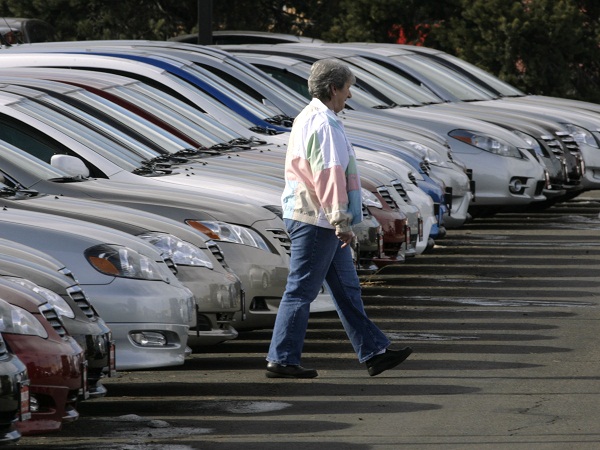Huge window switch recall hampers Toyota comeback

In this February 18, 2007 file photo, an unidentified buyer searches through long lines of unsold 2007 Corolla and Camry sedans at a Toyota dealership in Boulder, Colorado. Toyota Motor Corp. is recalling 7.43 million vehicles in the U.S., Japan, Europe and elsewhere around the world for a faulty power-window switch — the latest, massive quality woes for Japan’s top automaker. The recall, announced Wednesday, October 10, 2012 affects more than a dozen models produced from 2005 through 2010. AP/David Zalubowski
DETROIT — The largest recall in Toyota’s 75-year history could undermine the Japanese automaker’s comeback from natural disasters and embarrassing safety problems.
The company recalled 7.43 million cars, trucks and SUVs worldwide to fix faulty power window switches that can cause fires. Wednesday’s recall affects more than a dozen models produced from 2005 through 2010 including the Camry, the top-selling car in the U.S. It’s bigger than the 7 million vehicles recalled two years ago for floor mats that can trap accelerator pedals and cause unintended acceleration.
The problem centers on the power window switch, which is inside the driver’s door and controls when a window is opened or closed. Toyota said grease wasn’t applied evenly to the switch during production, causing friction and sometimes smoke and fire.
The flaw raises questions about whether Toyota Motor Corp. has solved quality and safety issues that embarrassed the company in 2009 and 2010. It also could jeopardize Toyota’s impressive rebound from last year’s earthquake and tsunami in Japan. Those disasters hobbled factories and left dealers short of models to sell.
The Toyota recall “takes some of the sheen off its recovering brand image and should have a financial impact,” Standard & Poor’s analyst Efraim Levy wrote in a note to investors. Toyota’s U.S. shares fell $1.60, or 2.1 percent, to $74.46 Wednesday afternoon.
Toyota said initially the window switch problem hasn’t caused any crashes or injuries. But documents filed by U.S. safety regulators show customers have reported 161 fires and nine injuries. No deaths have occurred.
The U.S. National Highway Traffic Safety Administration began looking into window switch problems with two Toyota models in February after noticing a higher than normal number of complaints. Most fires were minor, although one destroyed a Camry. Several owners reported that they were afraid to drive their vehicles because of the threat of fires. NHTSA said Wednesday the investigation remains open pending a review of recall documents.
Toyota said Wednesday it has received more than 200 complaints about the switches in the U.S., and more from other countries including 39 in Japan. Most of the complaints were about a sticky feel to the switches while pushing the button to raise or lower the window, but there also were complaints of the smell of smoke, company spokesman John Hanson said.
Toyota dealers will inspect the switches and apply special grease to them. In some cases the switches and circuit boards could be replaced, Hanson said. Some repair shops might have used off-the-shelf greases to fix the problem, but those eventually will make it worse, he said.
The recall includes 2.5 million vehicles in the U.S., where it covers about half the models sold under the Toyota and Scion brands.
Recalled U.S. models include the 2007 to 2009 Camry, Tundra pickup and RAV4 small SUV; the 2007 and 2008 Yaris subcompact; the 2008 and 2009 Sequoia large SUV and Scion xD and xA small cars; the 2008 Highlander SUV; and the 2009 Corolla and Matrix compacts.
Hanson said he was not sure if the recall will hurt Toyota’s sales, which have come roaring back in the U.S. after production recovered from the earthquake and tsunami.
Through September, Toyota sales were up nearly 32 percent compared with a year earlier, more than double the growth of the U.S. industry. Toyota also reclaimed the title of the world’s top-selling automaker during the first half of this year, wresting the crown from General Motors Co. Toyota sold 4.97 million vehicles globally in the first half, beating GM by about 300,000.
Analysts said it’s too early to tell whether such a large recall will hurt Toyota’s sales. S&P’s Levy, who downgraded Toyota stock from “Buy” to “Hold,” wrote that he hasn’t quantified the financial impact.
If Toyota makes its customers feel like they are being cared for properly as the repairs are done, there probably won’t be much of an impact, said Mike Jackson, director of North American production forecasting for IHS Automotive, a consulting firm.
“There’s a tremendous amount of loyalty to the Toyota brand,” he said. “Certainly it’s not going to be the primary point of consideration for most consumers out there.”
The window switch recall also highlights one of the risks of globalized car production: Automakers install the same parts on multiple models in different counties, saving money but exposing their lineups to big recalls if a part is flawed.
Toyota said it quickly identified all the models using the problem switches and took action. “We want to make sure that we addressed this issue quickly and effectively, and I think we are doing that with this recall,” Hanson said.
The recall covers only the master power window switch on the driver’s side, which controls all four windows. Switches inside the other doors are different, Toyota said.
Before the safety recalls two years ago, Toyota had a reputation for pristine quality, centered around its super-lean production methods that empowered workers to hone in on quality control. Toyota executives have acknowledged the escalating recalls were partly caused by the company’s overly ambitious growth goals.
Toyota is also suffering from a sales plunge in China where car buyers are shunning Japanese brands because of a territorial dispute over islands claimed by Japan, China and Taiwan.